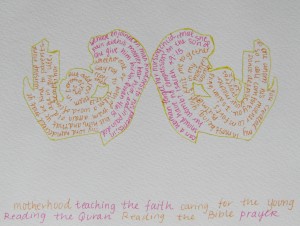Muslim Mother, Christian Mother
Reflection on Ziauddin Sardar’s Reading the Qur’an: The Contemporary Relevance of the Sacred Text of Islam (Week 2)

Reading the opening remarks of Ziauddin Sardar’s opening chapter entitled The Qur’an and Me struck a deeply personal. He begins, “I grew up reading the Qur’an on my mother’s lap”(3). I felt an immediate connection to his words as I had begun a paper for an existential phenomenology course several weeks early a similar way. The introductory remarks of my own paper read:
I first came to know God sitting on the front porch of during summer storms after the electricity had gone out. By flashlight, my mother would read to me from my children’s picture book Bible, and her soothing voice gave life to the promises of peace we read. Here, I came to associate God with both the might of the storm and the gentleness of my mother’s touch.
Thus, when Sardar remarked that for many Muslim children, their connection to the Qur’an is not distant or academic, but rather, “infused with associations of the warmest and most enduring of human bonds,” I felt as though I knew exactly what he meant (3). He describes the natural association of love for the text given the extremely personal medium through which he learned it (5).
I found another interesting parallel in our initial understandings of the sacred texts in our respective traditions: each was centered on love. For me, the love in the text was that of Christ’s absolute submission and sacrifice for those who he loved. For Sardar, he described a great love for God and His Words, unconditional – like that love between a mother and a child (5).
The timely pairing of our reflections led me to begin contemplating the role of motherhood in perpetuating the faith and why this duty so often falls upon the mother when there are often many other able adults in a child’s life. Perhaps the answer is one of pragmatics, but the rationale may also be that it is intuitive. In addition to nurturing a child’s physical needs, the mother seeks also to tend to her child’s spiritual needs. I’m curious about how one’s introduction to religion and the sacred text in one’s tradition impacts their hermeneutical orientation throughout the course of his or her life. I also wonder at what point in one’s journey of faith other influences begin to outweigh and overpower the pervasively peaceful context in which some learn about the divine in.
I am grateful for Sardar’s memoir as it provided an outlet to consider the role of motherhood in religion. For my artistic reflection (in case it is not clear), I have drawn two symmetrical silhouettes of a mother reading to her child. Within each silhouette I have written musings on motherhood and parenting from the sacred texts considered herein. The passages in the mother-child figure to the left are from the Qur’an and the figure on the right is comprised of Biblical phrases.